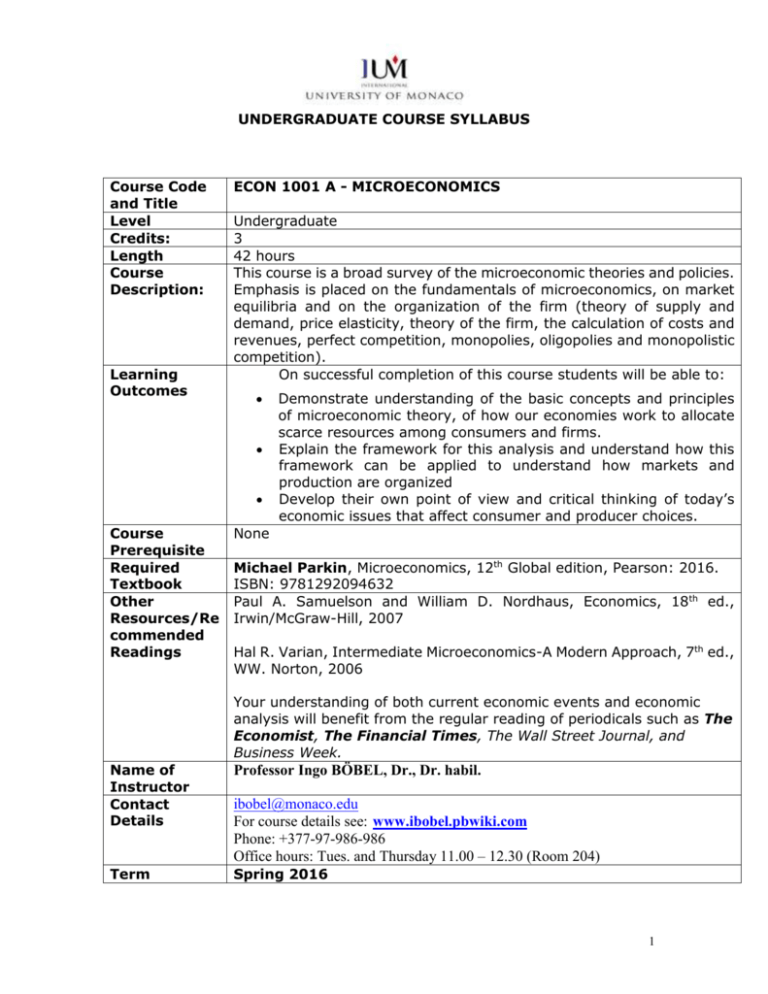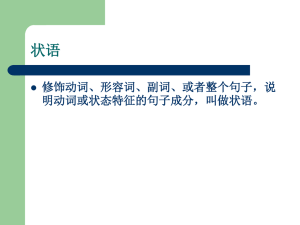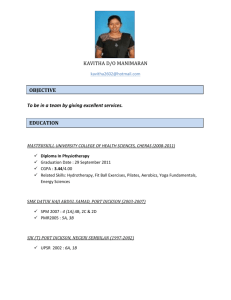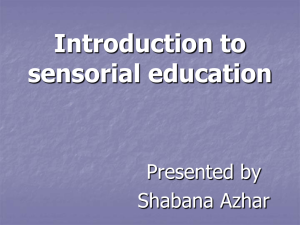Demand and Supply Cont`d.
advertisement

UNDERGRADUATE COURSE SYLLABUS Course Code and Title Level Credits: Length Course Description: Learning Outcomes ECON 1001 A - MICROECONOMICS Undergraduate 3 42 hours This course is a broad survey of the microeconomic theories and policies. Emphasis is placed on the fundamentals of microeconomics, on market equilibria and on the organization of the firm (theory of supply and demand, price elasticity, theory of the firm, the calculation of costs and revenues, perfect competition, monopolies, oligopolies and monopolistic competition). On successful completion of this course students will be able to: Course Prerequisite Required Textbook Other Resources/Re commended Readings Demonstrate understanding of the basic concepts and principles of microeconomic theory, of how our economies work to allocate scarce resources among consumers and firms. Explain the framework for this analysis and understand how this framework can be applied to understand how markets and production are organized Develop their own point of view and critical thinking of today’s economic issues that affect consumer and producer choices. None Michael Parkin, Microeconomics, 12th Global edition, Pearson: 2016. ISBN: 9781292094632 Paul A. Samuelson and William D. Nordhaus, Economics, 18th ed., Irwin/McGraw-Hill, 2007 Hal R. Varian, Intermediate Microeconomics-A Modern Approach, 7th ed., WW. Norton, 2006 Your understanding of both current economic events and economic analysis will benefit from the regular reading of periodicals such as The Economist, The Financial Times, The Wall Street Journal, and Business Week. Name of Instructor Contact Details Professor Ingo BÖBEL, Dr., Dr. habil. Term Spring 2016 ibobel@monaco.edu For course details see: www.ibobel.pbwiki.com Phone: +377-97-986-986 Office hours: Tues. and Thursday 11.00 – 12.30 (Room 204) 1 Class Meeting Times Methodology Tuesday and Thursday 8.30 to 10.00 am Attendance Policy Attendance is compulsory and will be taken at each class. It is ultimately the student’s responsibility to make sure all of the work for each course is completed. Students are expected to attend all examinations, presentations and inclass exercises. Missed quizzes, examinations or any in-class exercise will result in a 0% mark. Make-up examinations will only be permitted in exceptional cases and with the prior written approval of the Program Director or the Academic Committee. At the Undergraduate level, points are subtracted for absences. For more details, please consult the Handbook of Academic Policies and procedures Class Behavior Students and the instructor must respect and preserve the integrity of the learning environment of the classroom. Accordingly, disruptive behavior is not permitted, in particular, late arrivals and generally entering or leaving the classroom without authorization, any use of mobile phones, using computers for activities other than those of the class are not permitted. Hats should be taken off in class. Academic Honesty IUM views any form of academic dishonesty - cheating and plagiarism as unacceptable and subject to disciplinary action that will impact the course grade. Repeated incidents of academic dishonesty may lead to the student dismissal. For more details, please consult the Handbook of Academic Policies and procedures. Grades are given as percentage according to the US grading system described in the below table: Grading The course will be taught in an interactive and participatory mode through a mix of lectures, discussions, exercises and case analysis. Homework is assigned with the intent that students make an effort to understand the topic covered prior to the corresponding class so that they can fully benefit from the in-class discussion. Students: - must come prepared to each class by having read the chapters related to the course in the textbook - are encouraged to actively use the library resources when solving homework problems or any other assignments Letter Grade Percentage Range A 95-100% A- 90-94% B+ 87-89% B 83-86% B- 80-82% Quality of Work Outstanding/ excellent performance Good work 2 Course grade breakdown: C+ 77-79% C 73-76% C- 70-72% D+ 67-69% D 63-66% D- 60-62% F < 60% Acceptable work Poor work. Fails to meet minimum requirements The final course grade is consists of the following components and relative weight: Assessment event Relative Weight (coefficient) Homework incl. class participation 20 3 Quizzes 40 Final exam 40 TOTAL 100 Course outline Session / Date Topics covered / Activity planned 1 Course organization 12.1.16 2 Readings/ Assignments due Chapter numbers are from Parkin’s textbook What is Economics? What is Economics Cont’d. Demand and Supply Classroom exercises Ch 1. pp. 39-51 Read the Appendix on Graphs (pp. 53ff.) Ch 2. pp. 69-83 Ch. 2 pp. 69-83 Read pp. 91/92 Ch. 3 pp. 93-106 Demand and Supply Cont’d. Classroom exercises Ch. 3 pp. 93-106 14.1.16 3 19/01/16 4 21/01/16 5 26/01/16 6 28/01/16 Ch 1. pp. 39-51 Classroom exercises The Economic Problem Classroom exercises The Economic Problem Cont’d. Classroom exercises 3 7 Demand and Supply Cont’d. 2/2/16 8 4/2/16 9 Elasticity The price elasticity of demand Classroom exercises Ch. 3 pp. 93-106 Read pp. 107-113 Quiz 1 Ch. 4 pp. 121-137 11/2/16 Elasticity Cont’d The price elasticity of supply and other elasticities Classroom exercises Break Spring break 13.2.-21.2.16 10 Organizing production Classroom exercises Ch.10 pp. 261-279 Organizing production Cont’d Classroom exercises Organizing production Cont’d Classroom exercises Output and Costs Costs in the short-run Classroom exercises Output and Costs Cont’d Costs in the long-run Classroom exercises Perfect Competition Ch. 10 pp. 261-279 Ch. 11 pp. 261-279 Ch. 11 pp. 285-297 23/2/16 11 25/2/16 12 1/3/16 13 3/3/16 14 8/3/16 15 10/3/16 Ch. 4 pp. 121-137 Ch. 11 pp. 298-303 Ch. 12 pp. 309-329 Quiz 2 16 15/3/16 17 17/3/16 18 22/3/16 19 24/3/16 20 29/3/16 21 31/3/16 22 5/4/16 Perfect Competition Cont’d Classroom exercises Perfect Competition Cont’d Classroom exercises Monopoly Classroom exercises Monopoly Cont’d Classroom exercises Ch. 12 pp. 309-329 Ch. 12 pp. 309-329 Ch. 13 pp. 335-355 Ch. 13 pp. 335-355 Monopoly Cont’d Classroom exercises Monopolistic competition Classroom exercises Ch. 13 pp. 335-355 Ch. 14 pp. 361-373 Monopolistic competition Cont’d Classroom exercises Ch. 14 pp. 361-373 Quiz 3 4 23 Oligopoly and Antitrust Ch. 15 pp. 379-381 pp. 394-397 Externalities Ch 17 pp. 429-449 7/4/16 24 12/4/16 25 Revision (last class) 14/4/16 Last updated: January 7, 2016 5







